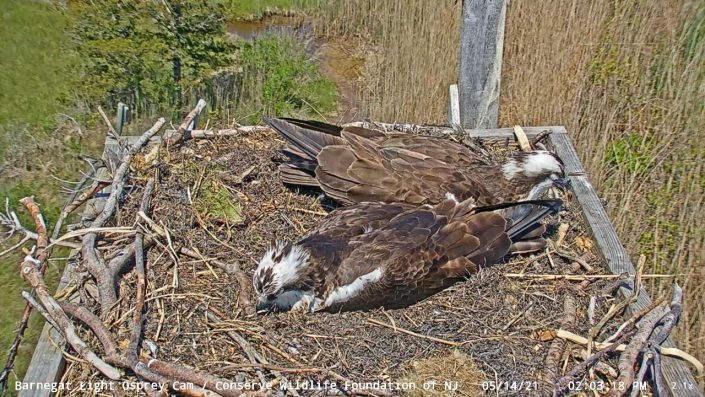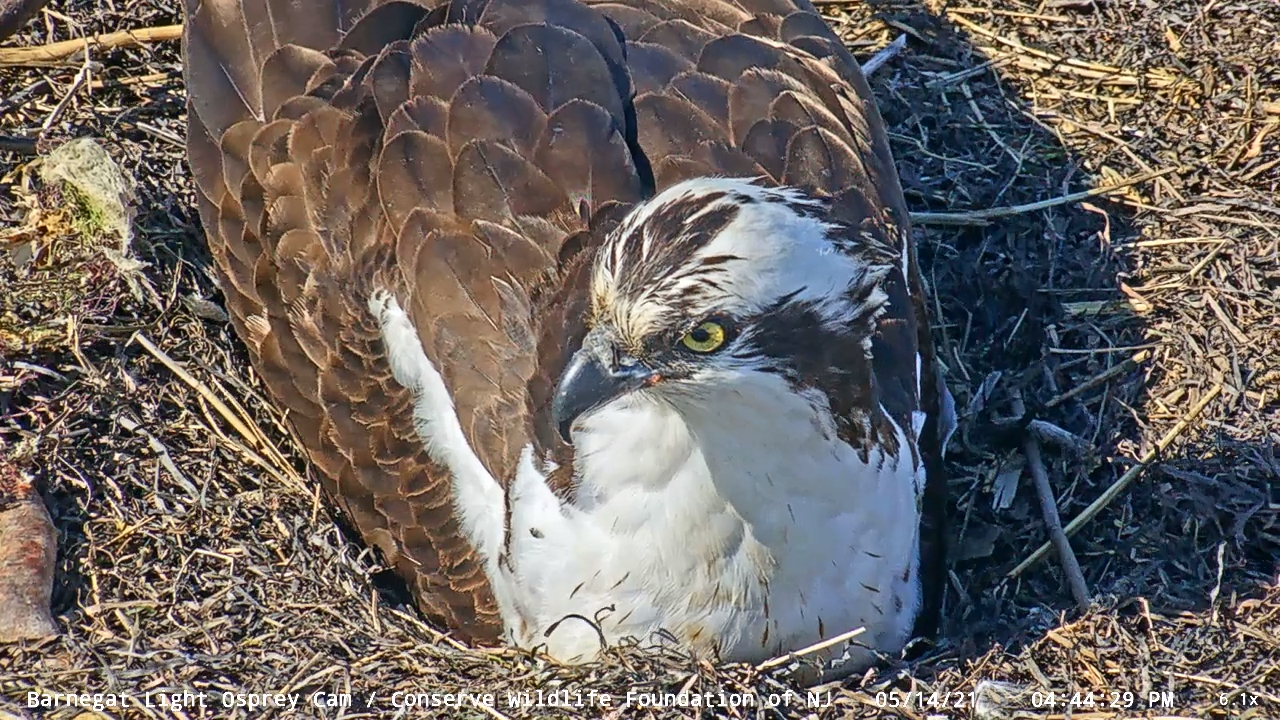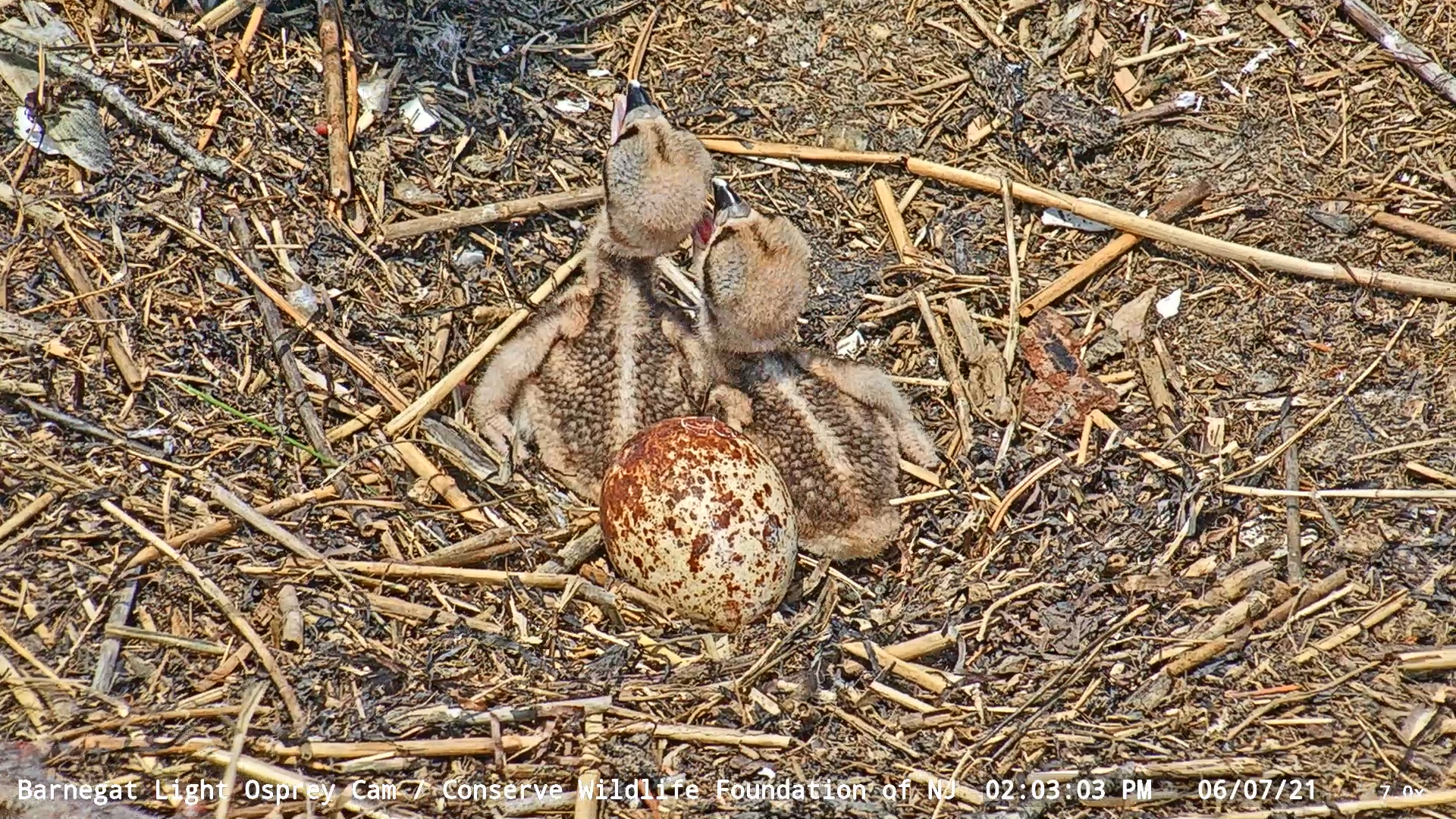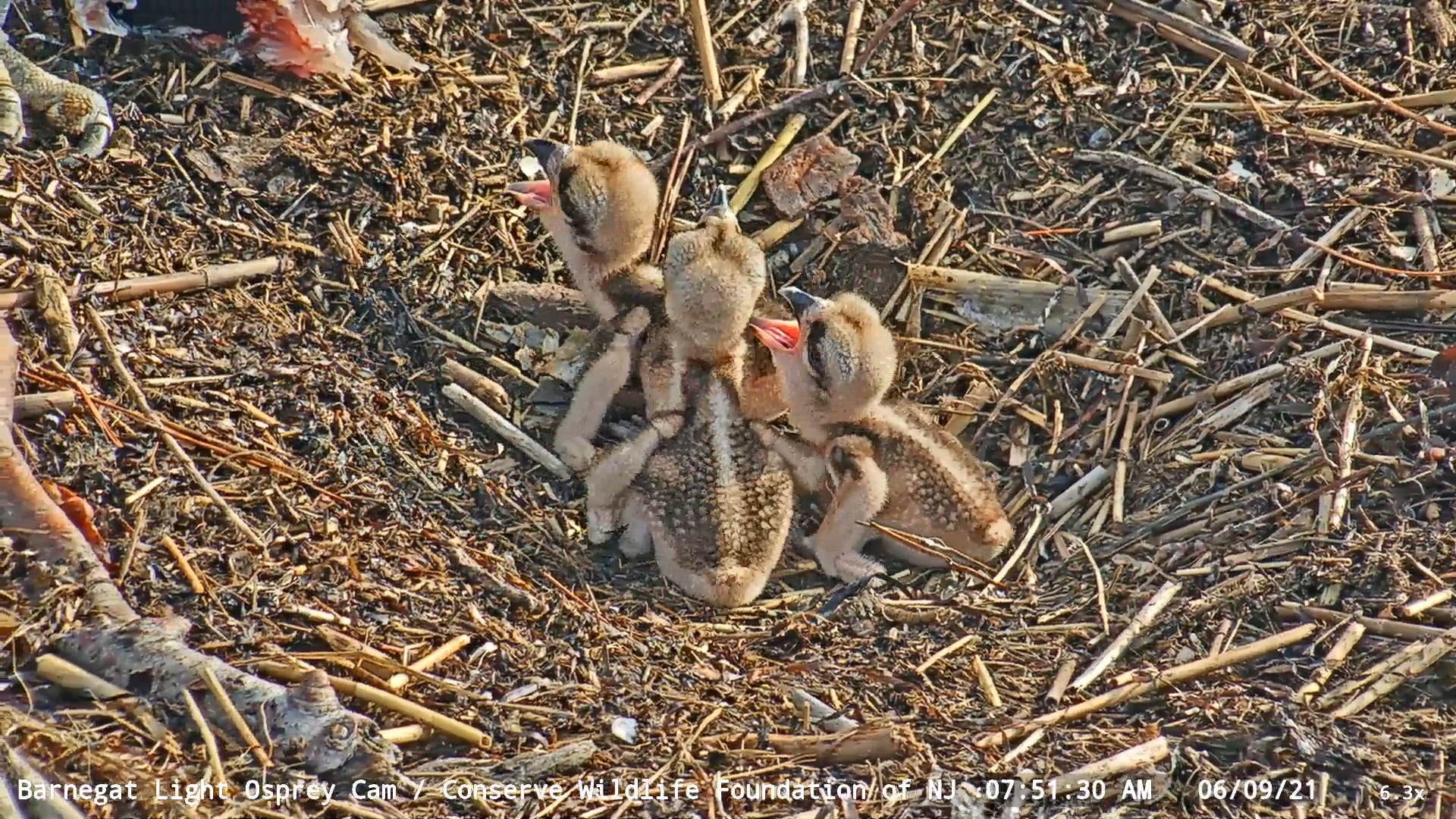Two are sometimes better than three
A season of change and hope at the Barnegat Light Osprey Cam.
by Ben Wurst, Habitat Program Manager
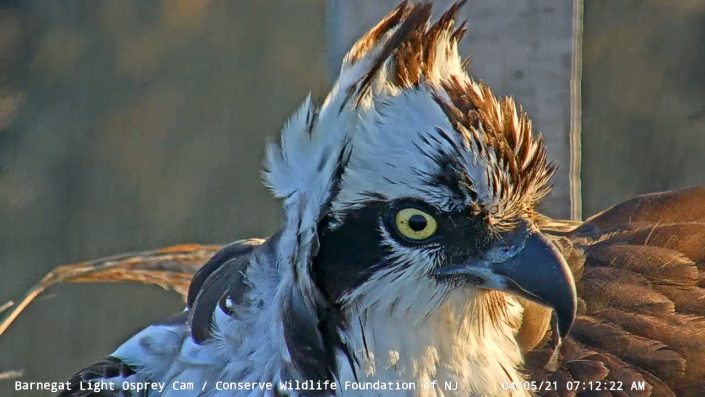
By far, this was the most viewed season of the Barnegat Light Osprey Cam, with over 360,000 views and 111,000 hours watched! It was a season of change. Viewers throughout the world watched as the mated pair successfully fledged two healthy young. We witnessed the trials and tribulations of a new pair, especially the female, who we believe attempted reproduction for the first time in her life. We saw that life as a young osprey was not always guaranteed, which is something we rarely get to witness but know is quite common at many nests throughout the world; however, with an experienced male and plentiful prey, the surviving young thrived. As we work on a season long highlight video, here is a brief summary of their nesting season.
The previous female, who nested here since we installed this camera in 2019 (she nested here in 2018 too, which was the first year at this nest) did not return from her wintering grounds. She was identified by her individual characteristics, including the plumage on her head (which is sort of like an avian fingerprint) and her irises. A benefit of having a high resolution camera that is close to a nest is that you can easily identify one individual from another by these uniques characteristics. Another is to read their leg bands, but the old and new females are not banded.
Despite this being a “new” breeding female this year, she is not new to this site at all. In fact, on April 5, 2020, she was observed on cam with a young male (Cowboy [6 yrs old] – band# 1088-08822). She was eventually outcompeted by the previous female who fledged three young in 2020. Fast forward to April 2021, well the new female was back, now named “Daisy,” and “Cowboy” was here to greet her!
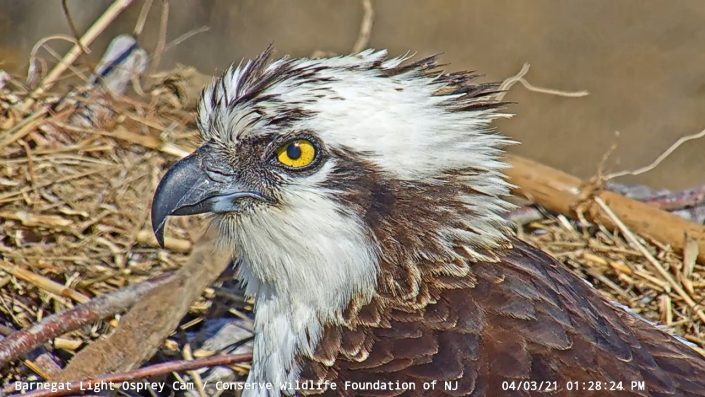
Although Cowboy and Daisy seemed to hit it off — he did deliver fish to his mate to strengthen their pair bond — but the relationship did not last. Around April 7, two males began to “Duke” it out, no pun intended. Was our soon-to-be 15 year old male back?!? Yes indeed he was! On the evening of April 8, we saw Duke perched on the nest and were able to ID him by his band. Viewers were so happy to see him back! We didn’t see Cowboy again…
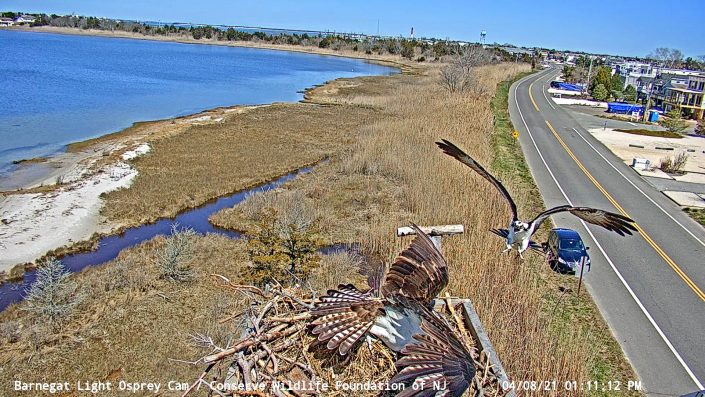

Duke won over Daisy with ease. As an experienced adult, he knew his role in their monogamous relationship — help spruce up their home & provide food for his mate and young. On that, he delivered!
The first of three eggs was laid on April 27, a bit later than the previous year and late in general, which isn’t surprising given the fact that this is a new pair. They needed to form a pair bond after-all… The second egg was laid on April 30 and the third on May 3. Since Duke is such an experienced adult, he knew the eggs needed to be protected and kept warm at all times. He often remained very close to Daisy as she incubated. Duke also helped ward off the never ending assaults of red winged blackbirds…
Ospreys typically incubate for ~40 days in the coastal zone. Eggs hatch asynchronously, since ospreys start incubating after the first egg is laid. This is a natural adaptation which gives the first to hatch/oldest nestling(s) the best chance of surviving, especially in times when prey is not as plentiful. This is referred to as brood reduction.
The first egg hatched on June 5 (day 39), second on June 6 and the third on June 8. Their first meal was on June 7. During this time the young need very close parental care and are brooded to be kept safe & warm.
Over the next week, we saw how the slightly older hatchlings were outcompeting the youngest and growing at a much quicker rate.
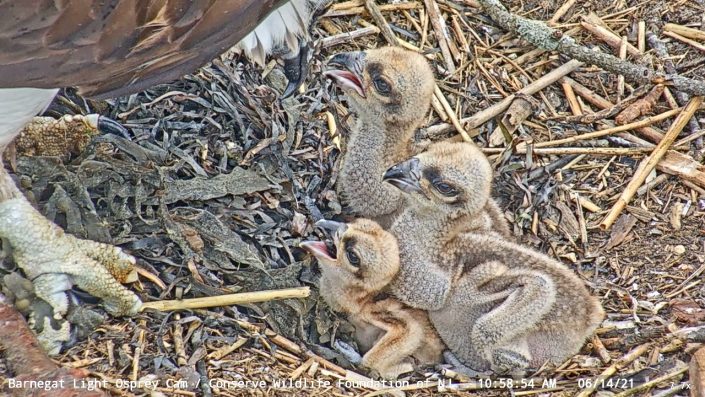

This usually happens when there is not enough prey to support all young. Abundance of prey has not been an issue with coastal nesting ospreys in New Jersey and especially with a very experienced adult male. But, with an inexperienced adult female, we saw how she consumed more of the fish instead of feeding it to the youngest. This lead to the older nestlings being much stronger than the youngest. Now they had more of an advantage to outcompete their smallest sibling during every feeding. At times it was hard to watch. Viewers rooted on #3, the youngest, as it fought for a meal and we all hoped for the best. This was all that we could do. This was the first time that I’ve ever seen brood reduction occur at one of our osprey cam nests since 2013.
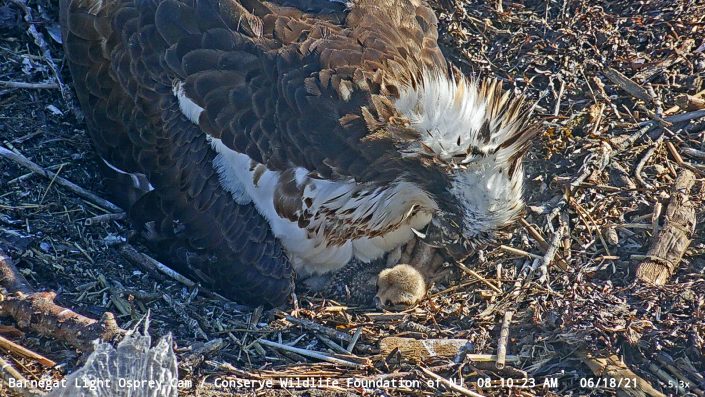
In the late afternoon on June 18, at ten days old, the youngest nestling (#3) had passed away. This was tough to watch, even for me, as a person who has worked over the past 15 years to help ALL ospreys thrive. But, I knew there was nothing we could do. We did not want to interfere with the balance of nature. We are just there to bear witness and learn. We were watching natural selection occur before our very eyes. This gave the two older siblings a much better chance of surviving to fledge and (hopefully) return as adults to carry on Daisy & Duke’s legacy.
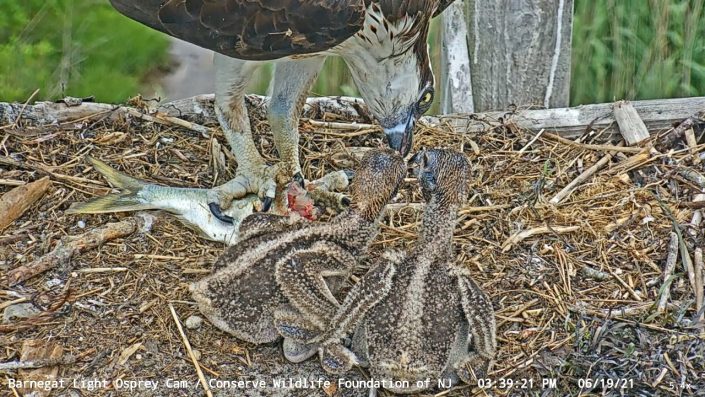
Over the next couple weeks we saw how the two nestlings flourished. They were just like any other baby. They ate, they slept. Repeat. At around 2.5-3 weeks old, they started to explore their home.
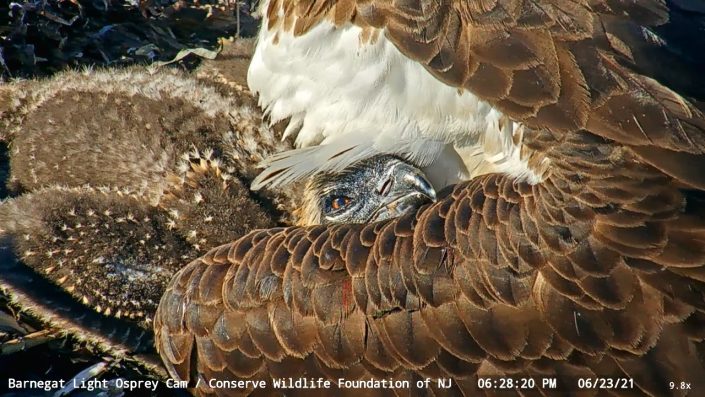
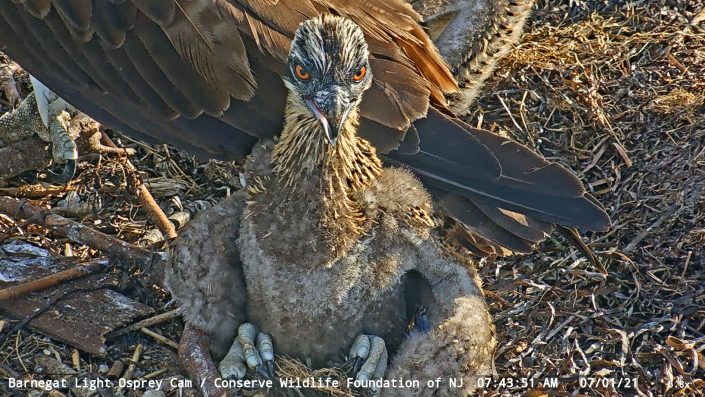
By four weeks old, they are around 75% of the size of a full grown adult and eat half their body weight, each and every day. That meant that Duke needed to forage just about non-stop throughout the day. He would come and go, often to the sound of Daisy, who screamed at him for food. Most days he would end up bringing 8+ fish to the nest to care for his mate and young. The total number of fish caught and delivered was well above 500 for the season…amazing!!
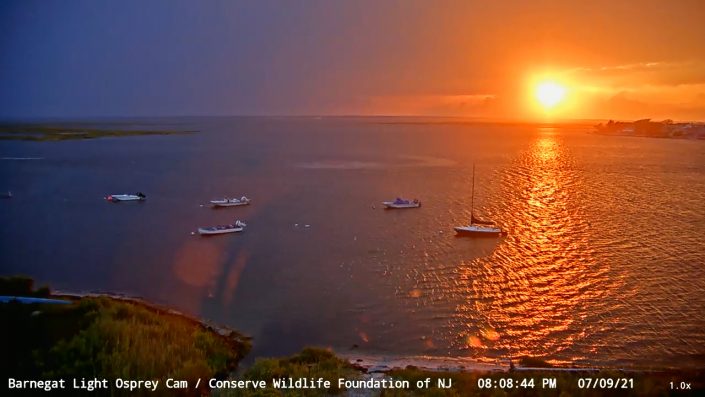

The two nestlings were scheduled to be banded when they were around 4 weeks old, which is the perfect time to conduct this work. They are big enough so that the bands won’t slide off their legs but not too big to leave the nest. When the adults are disturbed and call, they simply lay low to avoid detection. On July 9, the two nestlings were banded live on YouTube for future tracking, thanks to Roy and Ben with Pine Barrens Tree for their support!! 👊 They each received a red auxiliary band, in addition to their silver/aluminum federal band. The red band will allow us to learn more about them when they’re alive from re-sightings or encounters by birders, wildlife photographers or other wildlife biologists who read their band in the field.
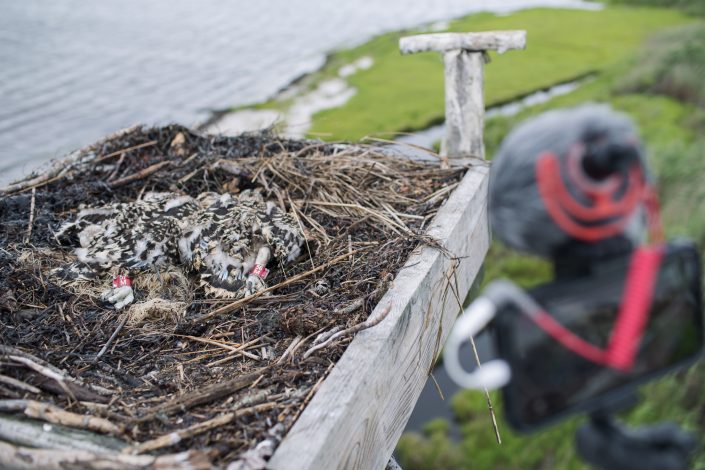
The nestlings continued to thrive and eat a lot of fish. They didn’t compete as much for the fish now, as they did when they were only 2-3 weeks old. The adult female did still feed them, but at around 5-6 weeks old, they begin to try to grab and feed themselves, as they become impatient with waiting for their share and naturally want to start using their sharp bill and talons to gain experience with holding and consuming fish on their own.
As we got closer to August, we saw Daisy step up and start to occasionally forage on her own. This is when the young are large enough to not be food for another predator, the young are eating more, and she needs to fatten up for her fall migration. 56 & 57 would often fight over pieces of or entire fish at times. Sometimes it resulted in flopping, live fish falling from their nest. A valuable lesson learned — grip the slippery fish tight with your toes and talons!
In the evening on August 29, a confirmed EF 2 with 115 mph winds touched down just north of the osprey cam nest. The camera streamed the extreme weather live as we saw the winds and heavy rain switch from east to west in a matter of seconds. The young knew to stay low, but Daisy got blown from her nest. She returned shortly after the storm had passed, but Duke was not seen until 4pm the next day. Many viewers were worried that he could have been lost in the storm, and if it passed a little to the south, then the outcome would have been much worse for these birds.
At around 13 weeks old, both young fledged on August 2. 57 fledged first and then 56 followed.
As they became more skilled at flying and landing, they took more and more flights from the nest. They would often perch on the ground by the small sheltered bay beach nearby, but would return to the nest to eat and rest at night. We learned how important the surrounding habitat is for young ospreys, like 56 and 57, to bath, practice flights and not be endangered by much human development.
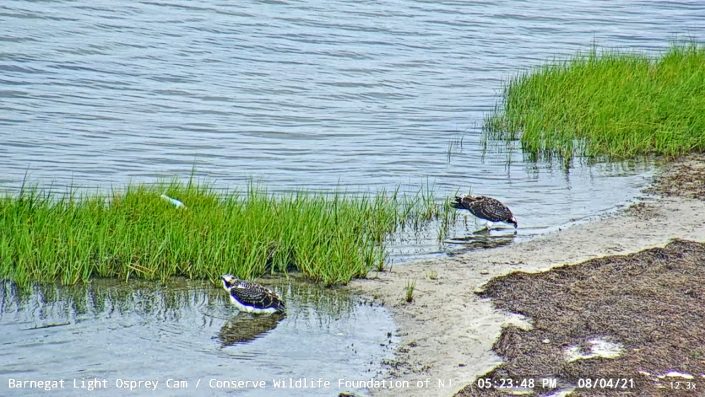

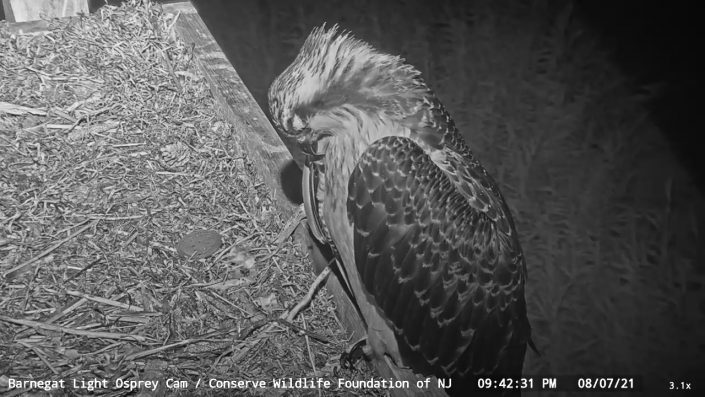
Over the next several weeks, after Daisy migrated south, the two young were supported by Duke until they gained the skills needed to catch their own prey. Daily trips away from the nest allow them to practice their foraging skills before migrating south. 56/M & 57/M, named “Sneezy” and “Heinz” by viewers, were last observed on the nest on September 18. They began their southward migration after a strong cold front passed through the region, which helped give them a boost when migrating south. Duke may still be around, but he has not been seen on the nest since. Osprey migration at Cape May usually peaks during the first week of October, so many ospreys are now headed south to their wintering grounds in tropical regions of the Western Hemisphere.

















We can’t thank our volunteer camera moderators and operators, J D and Beach Girl, enough for all their contributions this season! Most of the screenshots in this post were captured by them!! With their help the Barnegat Light Osprey Cam reached over 360,000 views this season. We are also very thankful for all who donate to support our Osprey Cam. The cam will remain online throughout the winter, but this fall we will be conducting some maintenance to the cam, so it will go offline for several days while this work is performed.
It will be a quiet winter without the ospreys but in ~180 days, they will be back!
Watch the Barnegat Light Osprey Cam live!
Donate to support the Barnegat Light Osprey Cam
Learn more about our work to monitor and manage ospreys in New Jersey!
Discover more from Conserve Wildlife Foundation of NJ
Subscribe to get the latest posts sent to your email.
